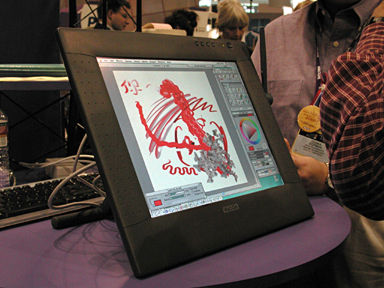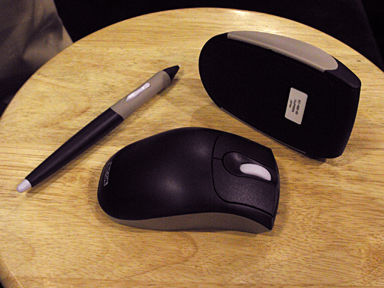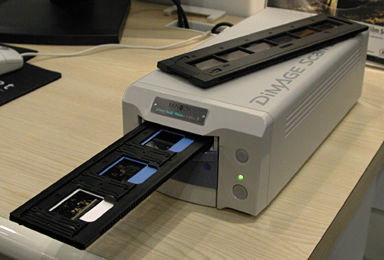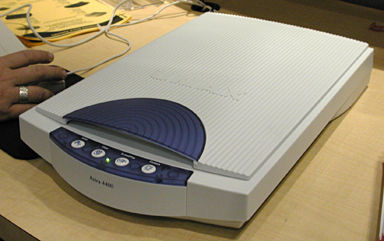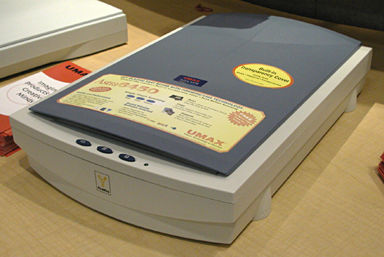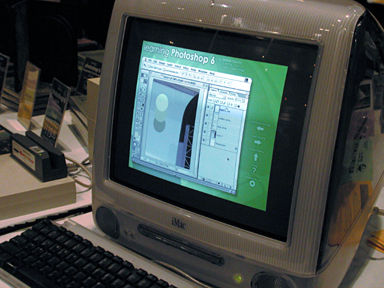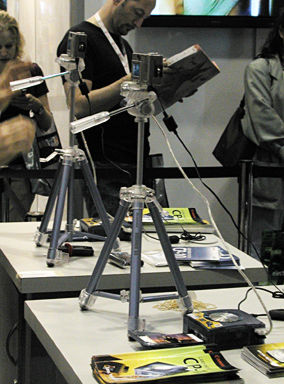| The Seybold SF 2001 report | |
SEYBOLD SAN FRANCISCO
Scanning the Product Parade
By MIKE PASINI
Editor
Imaging Resource Digital Photography NewsletterBen Franklin? Monsters? What were we thinking about yesterday? The floor of the Seybold exposition is littered with products.
Here's a round-up of what caught our eye today.
ANYBODY HAVE A PEN?
Sometimes it seems the parade of accessories for digital imaging includes anything you can plug into an electrical outlet. But as you spend more and more time in your image editor you may appreciate one cordless accessory in particular. A graphics tablet.
We've used a 4x5 pressure-sensitive Wacom graphics tablet for years. There are, simply put, things you can do with a pen that you can't with a mouse. Even if you are just burning and dodging.
So we were intrigued to learn Wacom introduced two new products at the show.
The Cintiq The Cintiq interactive pen display is to dream about. It's a 15-inch diagonal LCD display with 1024x768 pixels that tilts from 18 to 73 degrees. That's not an antenna on the side but a removable (and adjustable, up and down) pen stand. It's attached to the LCD because you draw on the LCD itself, not on a graphics tablet.
We were glad to hear it comes with an ICC color profile. But we were even happier to hear it's half the price of its predecessor. At $1,899 it still isn't cheap, though. And we found it a little sluggish, the effect trailing the pen movement slightly and noticeably with more complex brushes.
But Wacom has also updated its Intuos line of graphics tablets to the Intuos2 in five sizes ranging from 4x5 to 12x18. The Intuos2 features a new pen, two new high-resolution mice and oversampling technology.
The new pen adds a pressure-sensitive grip to the barrel. The rubber sleeve is removable, as is the rocker-style DuoSwitch that protrudes from it, so you can replace it with a solid grip with no switch on the barrel.
Wacom's New Pen and Mice
Note the mouse belly (r)With the Intuos2 line, Wacom now includes a cordless, battery-free, no-ball (but not optical) mouse. The two small tablets include a 2D mouse while the larger tablets feature a 5-button 4D mouse (whose belly is illustrated in the picture).
Wacom claims the two-time oversampling provides significantly improved "data quality" over previous models. It also makes the pens and tables incompatible with previous devices.
Drivers compatible with OS X and Windows XP are supplied, but the mice will function during startup on USB tablets without a driver installed.
Now if only some PR firm would give away promotional cordless pens instead of ballpoints.
NEW MINOLTA FILM SCANNER
We got our first look at the new Minolta DiMAGE Scan Elite II film scanner due for release in November. It is certainly compact, with plastic carriers for both 35mm film strips and mounted slides (with an optional APS adapter available, too).
The DiMAGE Scan Elite II And at under $1,000 with Digital ICE defect removal, Digital ROC color restoration and Digital GEM grain management technology, there isn't much this 16-bit scanner can't handle. In fact, if legacy faded slides are giving you Photoshop nightmares, Digital ROC will let you sleep like a baby.
The scanner features a 4.8 dynamic range, 2820-dpi resolution and multiple-sample scanning (to reduce noise by reading the same area 2-16 times).
We found the software straightforward and easy to use. Unique to Minolta, the software lets you save "snapshots" of scanner corrections in the left-hand column. Try a few variations, save each, compare them with a click. Once you've found settings you like, you can save them, too.
There's also a very handy color negative conversion setting.
The scanner includes both a USB 1.1 interface and a FireWire/IEEE 1394 interface but we'd recommend you use FireWire. A 35mm preview takes about 7 seconds and a scan 33 seconds with FireWire.
ELEMENTS EVERYWHERE
We notice a trend developing in software bundles. We're starting to see Photoshop Elements bundled with a number of products. The Wacom tablets and the Minolta scanner both include Elements (see our recent review).
NEW UMAX SCANNERS
OK, enough glamor. Let's get down under $100 and talk hardware.
UMAX demoed the $99 Astra 4400. With a USB interface, the 1200x2400 dpi single-pass scanner does 48-bit color. The 4450 model includes a transparency cover that illuminates up to 4x5 size film for $129.
The Astra 4400
48-bit color under $100Both models include buttons to quickly scan, copy or email/fax images. And software to "instantly edit" scans in Word or Excel.
The Astra 6450
With transparency adapterBut we were a little more interested in the slightly larger $129 Astra 6400 and the $179 Astra 6450 with the same transparency cover because they upped performance with a FireWire/IEEE 1394 interface (don't worry, it includes a PCI IEEE 1394 card for your PC). Specs are a little less spectacular at 600x1200 dpi and 42-bit color, but more than adequate for photo imaging.
We're in line to review both of these affordable scanners.
LEARN PHOTOSHOP ON A CD
You'd think a sophisticated audience like the Seybold crowd wouldn't have much interest in training materials, but business was booming at Lynda.com. Maybe that thirst for knowledge is why it's such a smart crowd.
Owned by Lynda Weinman, Lynda.com has put together a series of CDs on Photoshop 6. We took a look at the beginner CD titled Learning Photoshop 6, which was the most popular title sold at the show, just to cover our rear flank. But $149.95 Advanced Photoshop 6 and the combo Learning Photoshop 6/ImageReady for the Web CD also whetted our appetite, so we asked for review copies.
Learning Photoshop 6 From what we could see on the show floor, the CDs provide a simple-to-use interface to a series of QuickTime movies covering a wide variety of topics (even in the beginner title). You follow along as the presenter tells you what he's doing and why at a leisurely pace. There are hours of instructional material on each CD.
Since we first saw a Russell Brown QuickTime tutorial included with Photoshop, we've liked the idea of CD tutorials. So we have high hopes for these $149.95 titles.
LOSE ONE, WIN ONE
We were miffed that Canon didn't have an EOS-1D for us to play with, until we learned not only did the new Canon stay home but so did all the staff from New York. The Canon booth was manned entirely by West Coasties. And they all drove to San Francisco.
PowerShots cabled to CP-10 Printers But they were having fun. The digicam booth was busy as always and just a step or five away, Canon had set up a backdrop with the Golden Gate Bridge where attendees could pose to have their picture snapped. By the time you got off the set, the image had been printed on a Canon CP-10 300-dpi dye sub printer cabled directly to a Canon PowerShot digicam and presented to the attendee.
Our disappointment at not getting our hands on "the world's faster digital SLR" was slightly ameliorated when Canon's Michael Nadler showed us the product comparison between the EOS-1D and its competitors that he put up on the G4 PowerBook prominently displayed at the corner of the busy booth.
"I downloaded your product comparison," he confessed. "You're the only guys who have all the specs. And you guys tell it like it is." And there it was, straight from our camera comparison database.
Modesty forbid a screen shot
.
WRAPPING UP
We saw lots of products on the show floor, if less new ones than usual. And despite the most ambitious conference agenda in Seybold history, attendance is about a third of last year, we learned when we bumped into one of the conference chairs today. Show attendance in general has been declining over the past six months, he told us.
Which reminds us of the guy who said (some time ago), "It's the economy, stupid."
